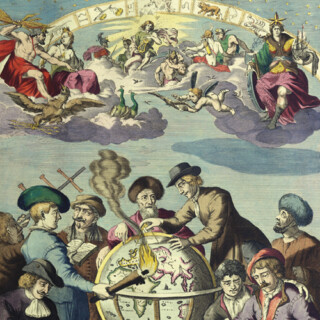Robert Morden

Robert Morden was a leading English mapmaker from the last quarter of the eighteenth century; his place and date of birth are not known, but it is thought he came from the north of England, perhaps the West Riding of Yorkshire. He was probably apprenticed to Joseph Moxon, who was born in Wakefield, Yorkshire, in the Weavers’ Company, and made free by about 1666.
Moxon was an engraver, mapmaker, globe-maker and instrument-maker, and Morden developed the same skills, although there is next to no evidence of him as an engraver. Morden worked with William Berry, also a former Moxon apprentice, from at least 1675; in 1677 they petitioned the Attorney General for “a licence to do all general and particular maps of the several parts of the world according to an alphabetical manner and method first projected by them against any other undertakers”. Although there are individual maps and globes prepared by the pair, the larger project never came to fruition.
This was very much a feature of Morden’s career; he was always plagued by lack of money; many of his most important maps were published in partnership with others, but the market for maps in England at this time was too small to sustain the number of mapmakers; Morden was to complain of his having “lain latent under the horizon of unknown obscurity, and irresistible poverty”.
His most famous works are, curiously among his least important but most successful: his pack of playing card maps of the English and Welsh counties, published in 1676, his Geography Rectified, a popular pocket-sized geographical text with maps, the maps he prepared for William Camden’s Britannia (1695) and The New Description and State of England (1701).
His separately published maps, because of their relative rarity are less well known, but many are of considerable importance, for example his maps of parts of America: with William Berry he published A New Map of the English Plantations in America (1673), A Map of New England New Yorke New Iersey Mary-Land & Virginia (1676) and R. Daniel’s A Map of ye English Empire in ye Continent of America (1679).
With John Thornton and Philip Lea, he issued A New Map of the English Empire, in the Continent of America (1685) composed around their maps of New England and the Carolinas, and with Thornton alone he issued This New Map of the chief Rivers, Bayes, Creeks, Harbours, and Settlements, in South Carolina (1695) and A New Map of Virginia, Maryland, Pensilvania, New Jersey, Part of New York and Carolina (1698).
He also published two important world maps: This Map of the World Drawn according to Mercators Projection (1676, with Berry) and This New Map of ye Earth and Water according to Wrights alias Mercator’s Projection (1699), on twelve sheets.
He produced several maps of the British Isles and England and Wales, Scotland and Ireland as well as plans of London, and a good sequence of maps of foreign parts, maps of theatres of war and so on, but did not have the range of stock to produce atlases of his folio maps, hence their considerable rarity today.







